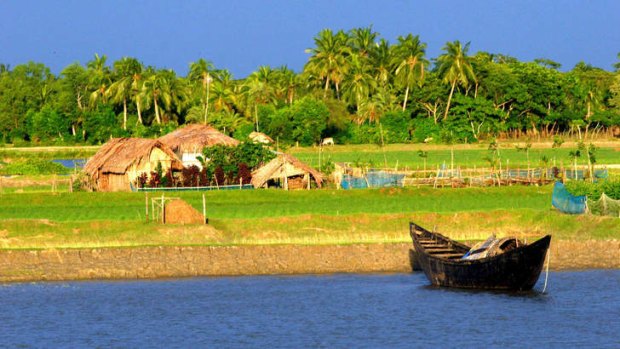
Mangrove forest in the Sundarbans.Credit: Getty Images
Been there? Done that? As Mark Dapin learns, there are still uncharted lands for the adventurers to explore.
I'd read warnings about travel in Bangladesh: the toilets are filthy, the kitchens are like toilets, and travellers will get sick. Hartals, or general strikes, regularly paralyse the state. In the villages, people are taken by Bengal tigers. But nothing filled my heart with quite as much fear as the item on day two of my Experience Bangladesh seven-day tour program: "In the evening, as part of their daily practice of affirmation of sustainable living, you will listen to songs by the neighbourhood fishermen, weavers and farmers."
If I were in my house, and the neighbourhood fishermen were in my dining room singing songs about sustainable living, I wouldn't come out of my bedroom until they had gone home.
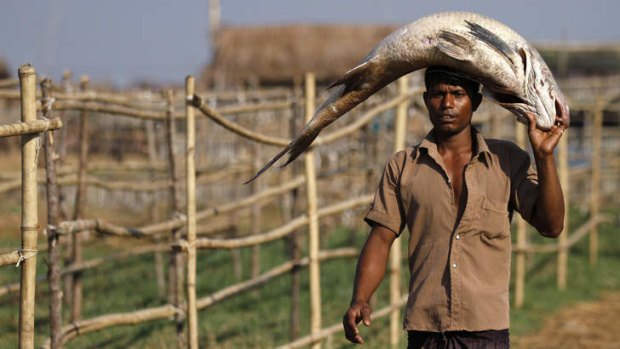
A fisherman with his catch.Credit: Reuters
So I was amazed when the villagers of Tangail put on the most moving, haunting and uplifting performances of folk music I've ever heard.
There's much that's amazing about Bangladesh: the beauty of the Sundarbans rivers, the ugliness of the Dhaka traffic, the richness of the curries, the poverty of the villagers, the sheer pulsating strength of the gaudy, unquenchable culture, and the trembling fragility of the social order.
The country of more than 160 million people sees only 360,000 tourists a year. They include Japanese visitors exploring the relics of its ancient Buddhist civilisation and British Bangladeshis returning "home" to their parents' villages, but almost no Australians. Experience Bangladesh, a company with offices in the US and, slightly incongruously, Nowra, NSW, hopes to encourage more Australians to make the journey. After all, we go everywhere else. The national carrier, Biman Bangladesh, which has a questionable reputation, doesn't fly to Australia. But the energetic and voracious China Southern Airlines has a fast connection via Guangzhou, China, and Experience Bangladesh plans to use China Southern for its local packages.
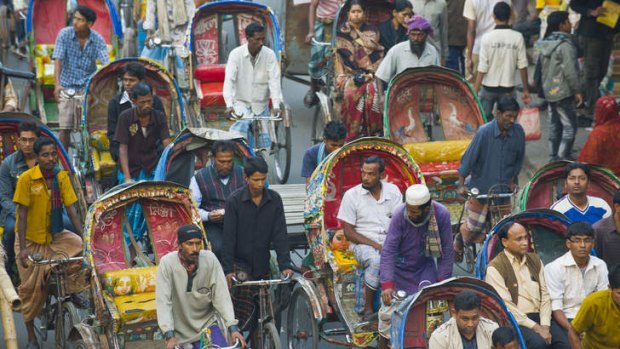
Dhaka's sea of rickshaws.Credit: Corbis
Although it takes only 3½ hours to fly 2330 kilometres between Dhaka and Guangzhou, the 21-kilometre journey from Dhaka airport to the city grinds on for two hours. The roads in Dhaka have reached such a level of overcrowding that vehicles can't really be called traffic. They're the opposite of traffic. They don't move anywhere. But people - such as hawkers, beggars, and a man carrying a basket of ducks on his head - weave among the cars and bikes, unfettered by the shackles of wheels. Even the city's 400,000 cycle rickshaws can't make much headway through the chaos.
The dispiriting drive to the hotel is broken by a visit to the national parliament building, which manages to look simultaneously like a pared-down, modernist Taj Mahal and a power station held together by packaging tape. In the members' dining room (which boasts all the grandeur of a Queensland roadhouse), the tour party and I are served a delicious chicken korma, which sets the standard for the unexpectedly fine food we're given time and again.
We "drive" into the narrow, congested streets of colonial Old Dhaka, where rickshaws are assembled in workshops by men who use their toes as clamps. Here, "rickshaw art" - the vibrant, kitschy paintings and decorations that lend the carts the celebratory shells of gypsy caravans - is for sale at about $10 for a back-seat piece.
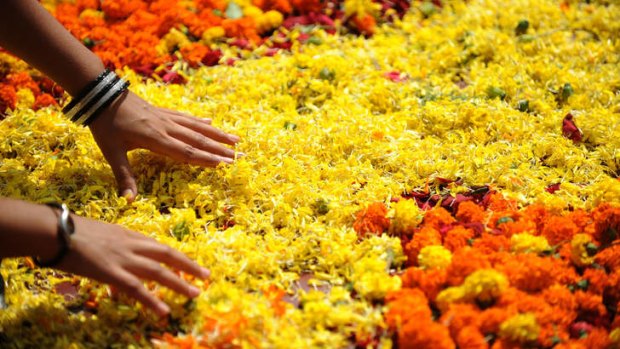
Decorating a Dhaka monument.Credit: Getty Images
We stay the night at the Pan Pacific Sonargaon, a five-star hotel with a marvellous buffet. I rise at dawn to swim in the outdoor pool, and watch the sun climb over the city and cautiously illuminate the armed guards on the hotel roof. The morning is warm but pleasant, as it is throughout Bangladesh in spring. The time to visit this country is November to February, avoiding the scorching summer and the June to July monsoon.
We drive 95 kilometres to Tangail, on roads that become less oppressive once we leave Dhaka behind. Tangail is a village of artisans, where most families weave elaborate saris on mechanical looms, while others mould earthenware pottery or handcraft rattan mats.
It's all done with a guileless integrity under the sponsorship of the UBINIG organisation, which teaches craftspeople they can make more money and live better lives by continuing with traditional ways. There's some evidence for this in the prices our group is prepared to pay for strikingly embroidered bags, but there's no hard sell, or even soft sell, in Tangail - it takes about 15 minutes for the weavers to decide how much to charge, and the marketing manager bursts into tears of joy when she sees how much money they have taken.
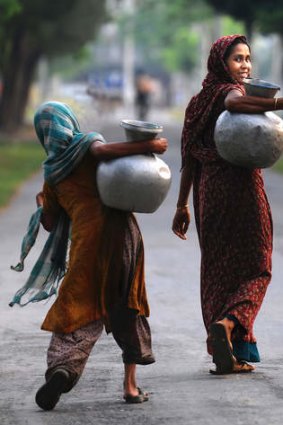
Women carrying drinking water.
In the evening comes the moment I've been dreading, when the farmers and fishermen gather with a few simple instruments to play songs they've composed themselves. Ominously, one of the early numbers is introduced with the un-thrilling line, "This song's going to be about vegetables", but it's definitely the best song about vegetables I've ever heard. The music has a ghostly, insistent, Celtic feel, and the vocals are something extraordinary. The third performer, Nobo Kumar Dey, a middle-aged man who describes himself as "a farmer as well as a singer", enacts a (gulp!) political analogy about fish, in furious but disciplined dance, while singing a complex, rhythmic ballad with all the fire and energy of first-wave punk rock. It's amazing.
Traditionally, the people of Tangail lived in mud huts, but most now inhabit sheds made from steel, a building method learnt from disaster-relief organisations. But the village guesthouse is part of the Biddhagarh (House of Knowledge), a concrete structure the size of a country motel, built over and around a courtyard where meals are served. Bangladeshis say village food tastes better because it is cooked in earthenware pots on clay stoves fired by local timber, and the feast laid on for us in Tangail is terrific. It includes dahl, parathas, two types of spinach curry, potato in mustard seed oil, chicken, prawns, and magnificent melt-in-the-mouth marinated beef kebabs.
I'll remember it long after I forget the guesthouse's rather challenging beds. (The mattresses aren't much thicker than the parathas.)
We fly south to Jessore - a 40-minute journey on United Airways, whose rather unsettling slogan is "Fly your own airline" - then drive for two hours to the town of Mongla, our gateway to the mangrove forests of the Sundarbans in the Ganges Delta.
If a tourist industry ever truly takes hold in Bangladesh, the Sundarbans, home of the Bengal tiger, will be at its heart. We cruise for two days in a comfortable, new five-cabin ship, ML Balawi, along rivers through jungle. In the early morning, it's lovely to watch the ghost structures of laden timber-freighters gain lines and life at the lifting of the mist and the rising of the sun. We share the waters with houseboats and fishing boats, motor boats and canoes.
We are looking for wildlife, but it largely evades us on a dawn boat ride and a later bushwalk - which I miss out on anyway because my bunk is so snug. The others claim to see a tiger footprint, but I would say that, too, if I were talking to someone who didn't go.
Although we don't come upon a Bengal tiger, we do meet a man in a village whose brother was killed by a tiger, and who is now involved with the local tiger protection team. He says tigers are "beautiful" animals, and he doesn't blame them for his brother's death. Tiger incursions are on the rise, although nobody knows why. In 2012, there were only 56 reported incidents of tigers entering Sundarbans villages, but there were 23 in the first six weeks of 2013 alone.
Previously, the villagers had tried to beat the tigers to death - but cornered, frightened tigers are the most likely to strike. Today, teams of volunteers patrol the village borders at night and, if they see a big cat, they sound an alarm and drive it back into the wilderness.
The team is to stage a demonstration but nobody seems to want to be the tiger. A tall, bearded man stands apart from his comrades when they bawl a megaphoned warning to the village. He rubs his chin and zips up his cardigan. A siren sounds, whistles blow, and he ignores them. The others bear down on him, thumping the ground with sticks - and suddenly the villager drops onto all fours. His hips turn into haunches, his teeth bare as fangs, his hands twist to claws, and he leaps at his tormentors like a cat.
The team tries to drive him back but he is fierce, implacable and carnivorous. He rounds on them and rears, then attacks again, agile, majestic and fearsome, before he finally flees and reverts to human form. I've seen tigers in zoos that looked less real.
We leave the ship to overnight in Khulna, a town near Mongla. On the way to the spotlessly clean, airconditioned City Inn, we stop at Bagerhat, whose impressive archaeological sites include the magnificent Sixty Dome Mosque (which, oddly, has 77 domes).
On the last day, we are supposed to fly our own airline from Jessore back to the capital. However, an Islamist opposition party has called a general strike, which means rickshaws and ambulances (which are supposedly exempt) are the only safe transport out of Khulna. The hartals don't target foreigners, but that doesn't mean we can ignore them.
Our endlessly resourceful guides consider hiring two ambulances and smuggling us to the airport, but abandon the idea in favour of a journey by auto-rickshaw, train, and then another auto-rickshaw. As usual, it takes two hours to cover a short distance, but the crisis offers a chance to experience Bangladesh like a Bangladeshi, with all its rickety infrastructure, from the make-do-and-mend upholstery on the antique train to the ceiling fans that seem to be ordinary household fans nailed to the ceiling.
It's surprisingly enjoyable - and no, I don't usually enjoy that type of thing - and a bit like Race Around the World, until I read in The Daily Star that an ambulance carrying a heart-attack victim was stopped and "vandalised" by Jamaat supporters, and the patient died before reaching the hospital. Another man was killed when a strike-breaking minibus was overturned.
Not all the warnings about Bangladesh stand up. Experience Bangladesh takes elaborate precautions with food hygiene, and none of its travellers has fallen ill. The village cooking is wonderful. It's a friendly, hospitable country, bursting with life. But for the people of Bangladesh, there are far worse dangers than Bengal tigers.
Mark Dapin travelled courtesy of Experience Bangladesh and China Southern Airways.
FAST FACTS
Getting there China Southern Airlines has a fare to Dhaka for about $970 return from Sydney and Melbourne, including taxes. Fly to Guangzhou (about 10hr) and then to Dhaka (4hr 15min). See www.flychina southern.com. Layover times in Guangzhou are from 2hr 35min outbound and 3hr 35min inbound.
Touring there Experience Bangladesh can tailor tours to individual interests, and has six group tours scheduled for 2013. Seven-day Taste of Bangladesh tours depart on June 1, September 22 and October 27, $1220 a person, twin share. Five-day Sundarban Wildlife tours depart on May 25, September 29 and October 20, $1040 a person, twin share. Single supplements are available, international airfares not included.
Contact Craig O'Regan, White Sands Travel. Phone 1300 730 133 toll-free, email sales@experiencebangladesh.com.au.
More information experiencebangladesh.com.au.
ALL THINGS RICE
At Tangail village, a small man with a dark, weathered face sings a song in which he names 127 varieties of rice, and describes how each strain is used. Rice is like wine to the Bangladeshis. They know it by its harvest and its age. They take their curries, which are generally simpler and more restrained than Indian dishes, with either rice or roti-like flat breads called paratha. Paratha and dry potato curry, eaten with the fingers, makes an unfeasibly moreish breakfast. The Bangladeshis also cook fantastic spinach curries and a simple-but-delicious dish of mashed potato in mustard-seed oil. Sadly, the local favourite, biryani, is consistently disappointing. It's often made with mutton that's little more than lamb bones. The kebabs — marinated, skewered, grilled meats — can be mouth-watering. The fish seems a little ordinary. The finest food on our trip is at the Pan Pacific Sonargaon in Dhaka and the guesthouse at Tangail.
Sign up for the Traveller Deals newsletter
Get exclusive travel deals delivered straight to your inbox. Sign up now.